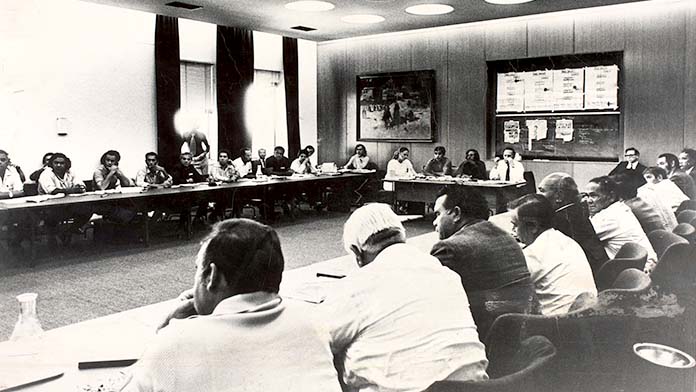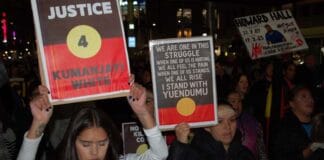An Indigenous Voice to Parliament would only be the latest in a succession of Indigenous advisory bodies that have all been ignored and then scrapped, writes Jasmine Ali
Labor’s plan for an Indigenous Voice to Parliament is being promoted as a transformative reform that will solve all manner of critical issues.
Indigenous Affairs Minister Linda Burney, for example, argues that the current social crisis in Alice Springs would have been avoided if a Voice was already in place “because we would be getting practical advice from people who are representative of the community”.
But the government receives no shortage of advice from many different Indigenous representative bodies.
It’s not a lack of understanding of Aboriginal needs and perspectives that leads to destructive policy. Powerful interests in Australia benefit from the continuing, grinding oppression of Aboriginal people and the unfettered exploitation of Aboriginal lands.
Since the early 1970s, often under pressure from demands for self-determination, both Labor and Liberal Federal governments have set up and disbanded national advisory bodies.
Time and again, Aboriginal leaders became frustrated at the severe limitations imposed on them. Yet the proposed Voice to Parliament maintains the weakest features of previous advisory bodies.
National Aboriginal Consultative Committee
In 1973, the Whitlam Labor government established the National Aboriginal Consultative Committee (NACC). This was a moment of real hope in Aboriginal affairs.
Radical Aboriginal rights protests, such as the Gurindji strike that started in 1966, had culminated in the establishment of the Aboriginal Tent Embassy in 1972.
These protests helped kick out the Liberals and forced Labor to articulate a clear break with the policy of assimilation, promising “self-determination” as they took office. Whitlam established a Department of Aboriginal Affairs (DAA) led by a minister, Gordon Bryant, who initiated the NACC by creating an Aboriginal electoral roll and holding national elections. Forty-one representatives were elected from a total of 193 candidates.
Buoyed by broad momentum for change, about 75 per cent of the adult Aboriginal population enrolled to vote and 80 per cent of those enrolled voted. This would prove to be an historic high point for Aboriginal participation in such processes.
Several prominent Aboriginal activists were elected, including Harry Hall from Walgett, a former shearer and union activist who won union support for protests in 1964 against the jailing of two young boys from his community. In Melbourne, Bruce McGuinness, who popularised ideas of “Black Power”, was elected and radical union activist Chicka Dixon helped get candidates elected.
The NACC had scope to advise the minister in relation to “all matters affecting Aboriginal people”. In 1976, it declared all Aboriginal prisoners held in Australian jails were political prisoners. It said: “These prisoners have never been given the opportunity to understanding their position as Aborigines within the total alien white Australian society and that they were victims of that society.”
The NACC also called for a royal commission into police brutality towards Aboriginal people across Australia and called to protect sacred sites and oppose mining operations in Kakadu National Park and Aboriginal reserves.
But from the outset, the NACC’s effectiveness was stifled by government. Black Power militants like Paul Coe called its establishment an exercise in “lip-service” and “political propaganda” by the Whitlam government because it had only an advisory role with “no guarantee its recommendations will be implemented”.
On top of this, the NACC was entirely dependent for funding on the newly created DAA. This meant the department controlled the timing and funding of NACC meetings, which effectively meant government approval was needed to convene meetings.
The DAA was staffed by officials who came from old State Protections Boards, which had been responsible for forcibly removing Aboriginal children from their families, as well as others drawn from Australia’s colonial administration in PNG.
Frustrated by these problems, in early 1974, the NACC challenged its advisory status and passed a resolution which empowered the body to have direct responsibility for the expenditure of funds allocated to it. This was met by open hostility from both the Whitlam and Fraser governments.
The Liberal government threatened to cut off funds to the body if it did not behave as “advisory” and suspended members in 1977 when the NACC adopted a new constitution.
That year, Harry Hall argued the NACC was “ineffective by design”, with no powers or autonomous budget. Later he commented that “the government had not intended the committee to advance the cause of Aborigines”.
In 1977, Minister Ian Viner launched a review which openly disparaged the NACC, saying that many of its proposals did not constitute what the government considered to be “advice”. The Fraser government abolished the NACC and created its own National Aboriginal Conference (NAC).
National Aboriginal Conference
Fraser had hoped that the NAC would be more compliant and fall in behind government policy, designing even tighter controls.
There was no obligation on the government to consider any advice produced by the NAC, nor was there any minimum guarantee of ministerial access. Even worse, rather than being empowered with a broad mandate to speak on important issues, NAC’s charter only allowed it to consider questions referred to it by the minister.
Early discussions at the NAC, led by its chairman Jim Hagan, revolved around whether Fraser would enter negotiations on a treaty (makarrata) with it. But the NAC’s advice was ignored.
In 1983, Rob Riley, a NAC national executive member from WA, said: “We are in a position where we appear to be totally disregarded by the state and federal government. I can cite numerous examples where recommendations and advice have been given to the Western Australian and federal governments, but which has fallen on deaf ears.”
Riley pointed out that the WA government had not even acknowledged receipt of the advice.
It wasn’t the NAC’s “advice” but radical mass protests in 1982 at the Brisbane Commonwealth Games by thousands of Aboriginal people and their supporters which pushed the issue of land rights back onto the political agenda.
The Hawke Labor government won in a landslide victory in 1983 promising the introduction of national land rights legislation, a treaty and spending on “social justice”.
The NAC sat on the government’s land rights steering committee and Labor Minister Clive Holding told parliament that approval for legislation would be sought from NAC before it was be put to parliament.
At the start of his term, Holding outlined that the government’s policy would include support for five principles: inalienable freehold title for Aboriginal land; full legal protection of scared sites; Aboriginal control over mining on Aboriginal land; access to mining royalties; and compensation for land lost.
But after the mining and pastoral industries, supported by WA Labor Premier Brian Burke, waged a vicious racist campaign against the proposed legislation, Hawke capitulated and proposed a model which trashed these five principles.
The NAC openly opposed Hawke’s sell-out. In July 1983, as the NAC’s opposition to government policy grew, Labor announced an inquiry into NAC under the pretext of strengthening the organisation. In 1984, Riley and other NAC members walked out of a WA land rights conference in protest at the state government’s attempts to “railroad Aboriginal groups.” By the time the review was released in 1985 the government was committed to shutting the NAC down.
In 1986, Hawke withdrew the national land rights legislation and buried land rights, while his Minister for Aboriginal Affairs, Gerry Hand, recommended the creation of a new body to advise the government, the Aboriginal and Torres Strait Islander Commission (ATSIC), which Labor established in 1989.
ATSIC differed in important respect from NACC and NAC, being the first national body given powers to fund and deliver programs.
There was a constant tension between Indigenous aspirations for self-determination in policy design and service delivery and continuing government attempts to maintain control.
While ATSIC’s representative arm was elected, the administrative arm was staffed by public servants. The Minister of Aboriginal Affairs directly appointed two commissioners as well as the chair of the board.
Program delivery was limited to certain areas and ATSIC had its own “special accountability unit” with a more arduous standard of reporting than any other government agency.
Despite this, the Liberals under John Howard cut budgets for organisations funded through ATSIC and constantly demonised the body as corrupt and responsible for the shocking conditions found in Aboriginal communities.
While formally given powers to provide advice, in practice, as a report by Social Justice Commissioner Tom Calma found in 2008, “government rarely sought advice from ATSIC and rarely adopted it when it was offered”.
Belief among the Indigenous community that a national body could deliver change had plummeted by the 1990s, with fewer than 20 per cent participating in ATSIC elections. ATSIC leaders themselves consistently expressed frustration with cuts and controls, calling for greater self-determination and criticising Howard’s racist agenda.
Then in 2004, with the support of Labor, Howard abolished ATSIC and announced it would be replaced by an “appointed advisory body of distinguished Indigenous people”. Indigenous Affairs Minister Amanda Vanstone argued, “We believe very strongly that the experiment in elected representation for Indigenous people has been a failure.”
Real change
The proposed wording for a Voice to Parliament maintains the weakest features of previous advisory bodies.
Albanese’s constitutional amendment will provide no rights, includes no guaranteed budget, confines the body to an advisory role and allows its composition, functions and procedures to be entirely controlled by the government of the day.
Any Voice that comes into conflict with government—as with the NAC’s stand over land rights—will still be able to be ignored or replaced.
History shows that just being allowed to give “advice” is never enough to realise Aboriginal aspirations. Real change requires large-scale collective action that threatens the powerful interests keeping Aboriginal people oppressed.






